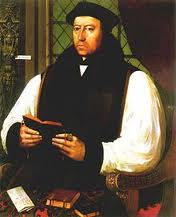In Parts I and II we examined the background events and players in the English Reformation that led up to the breach with Rome and the creation of the Church of England. In this post, we’ll examine the actual breach itself and look at some of the key players involved in these events.
In Part II we discussed how Cardinal Wolsey fell from favor with Henry VIII by failing to procure the King’s annulment. After Wolsey’s fall his secretary, Thomas Cromwell, began to emerge as Henry’s most trusted adviser and would eventually become Lord Chancellor (after the execution of Thomas More) and help lead the English Reformation.
Cromwell’s partner in these events was Thomas Cranmer, a priest and theologian from Cambridge who proposed that Henry’s case for annulment be put to leading intellectuals from the great universities of Europe. Henry had Cranmer travel to Rome in 1530 to argue his case personally.
The Parliament of 1529 was strongly anti-clerical and in 1530, urged on by Cromwell, began to take steps to establish the King’s authority over the English church. The entire English clergy (remember, they were Roman Catholic at the time) was charged with Praemunire, which, as we discussed in Part II, was an English legal doctrine that held you could not serve the King and a foreign master (i.e. the Pope) simultaneously. The clergy, led by then-Archbishop of Canterbury William Warham, agreed to a settlement with Henry in which they paid a significant fine and received a pardon. The Pardon of the Clergy also required the clergy to admit that Henry was the Supreme Head of the Church of England, “so far as the law of Christ allows.”
Parliament, urged on by Cromwell, continued to take action against the church and in 1532 passed the Supplication Against the Ordinaries, which was a list of grievances against the English church by parliament. Some of the grievances included the independent legislative powers of the church in such areas of marriage.
Warham, who was ailing at the time, settled this matter as well with a settlement known as the Submission of the Clergy, where the English church agreed to have its canons reviewed by the King, who could veto any legislation passed by the Convocation, which was the governing council of the church.
Shortly thereafter, Warham died and Henry VIII appointed Cranmer as Archbishop of Canterbury. Cranmer, who was traveling in Europe at the time, perhaps knew the challenges (or dangers) of working so closely with Henry, and tried not to respond to the letter as long as he could. In the end, however, he accepted the appointment and the Papal Bulls, or formal order, appointing him to the position arrived in England by March, 1533. Henry was so enthusiastic to have Cranmer as Archbishop that he paid for the bulls from his own funds (at that time the customary fee for a Papal Bull was the one year’s income from the benefices held by the office).
After Cranmer was consecrated Archbishop in March, 1532 Parliament continued to move against the Pope. They passed the Act in Conditional Restraint of Annates, which halted the payment for Papal Bulls for offices such as bishoprics (the money went to the Royal Treasury instead) and in 1533 passed the Act in Restraint of Appeals, which denied appeal to Rome in cases of marriage and other matters, and instead gave final authority in these matters to Henry’s archbishop, Thomas Cranmer.
Parliament acted again in 1534 and passed the Act of Supremacy which confirmed Henry’s title as the Supreme Head of the Church of England, effectively separating the church from the Pope. Opposing the Royal Supremacy was punishable by death.
After the Act in Conditional Restraint of Annates, Henry appealed to Cranmer regarding his marriage. Cranmer annulled Henry’s marriage to Catherine of Aragon in May, 1533 and validated Henry’s previously secret marriage to Anne Boelyn. On June 1, 1533 Cranmer crowned Anne as Queen of England. Pope Clement VII’s response was to excommunicate Henry, Anne, Cranmer and others unless Anne was repudiated. This, of course, did not occur and Anne, who was pregnant when she secretly married Henry, gave birth to the Princess Elizabeth on September 7, 1533. An excellent timeline of these legislative acts can be seen here.
The English Reformation had begun. The Church of England was free from Rome, but it wasn’t remotely Anglican and still very Catholic. Mass was still said in Latin, priests were supposed to be celibate, and the calendar of the saints was still followed.
What distinguishes this part of the English Reformation was that it wasn’t a reformation in terms of doctrine, but rather, some excellent lawyering on the part of Cromwell and his allies in the Reformation Parliament. It was a reformation by statute, not from changed doctrine.
The emergence of protestant ideas would come in the next phase, from committed Reformers such as Cranmer, Cromwell, and others. But with the King a fairly contended Catholic, how far would they go? We’ll address that in our next post on the English Reformation.



